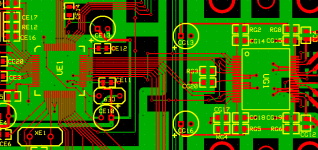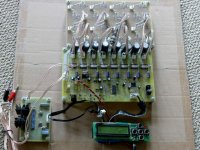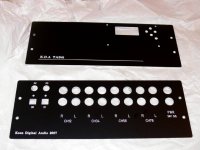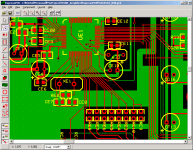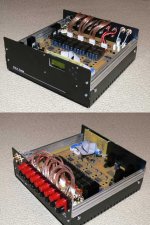Does anyone want to play with TAS5518 full digital amplifier?
This is my prototype board, and now I'm working with ver.0.2 so it can be passed to you. I think many person have interests in TAS5508/5518 but it's hard to take off. and I need brother in arms.
Board construction:
(1) main digital board, CS8416 - TAS5518 - TAS5121 x 8. accepts I2C control, and generates raw PWM signal.
(2) filter board, large 10uH coils, film capacitors, etc
(3) AVR ATmega128 and LCD, button board. http://microcontrollershop.com/product_info.php?products_id=588
(4) Simple variable voltage power supply, using LM317
What you get:
(1) boards, source code, schematics, board layout file (made by www.expresspcb.com software), connector and pins for speaker output.
functions are, volume control with variable voltage, 8 digital input selection, LPF/HPF/EQs/level offsets/mutes. can create 4 way 24dB/oct integrated full-digital channel crossover and amplifier with volume control. Output power is about 20W total.
(2) 10 question support incident
What you need:
You have to be diyaudio member, to send e-mail to me.
AVR programmer / debugger, and of course knowledge of AVR GCC language.
of course you should used to be digital amplifier, diy, wiring, soldering.
Power supply, I was using 18V/3A Lab DC power supply.
diy and at-your-own-risk mind. I used this board to play $4,000 speaker for months, but AT YOUR OWN RISK.
Price:
I spent thousands$ until this board works but adequate price will be around $150 including shipping in USA (just to block non-serious person). I hope you already have knowledge about TI full digitals, and interests, also to be serious. Please contact me if you interested in.
(If this post is not appropriate for this thread, please remove > moderators )
PLEASE DO NOT REPLY HERE, SOME KIND OF OFF TOPIC ISSUE.
This is my prototype board, and now I'm working with ver.0.2 so it can be passed to you. I think many person have interests in TAS5508/5518 but it's hard to take off. and I need brother in arms.
Board construction:
(1) main digital board, CS8416 - TAS5518 - TAS5121 x 8. accepts I2C control, and generates raw PWM signal.
(2) filter board, large 10uH coils, film capacitors, etc
(3) AVR ATmega128 and LCD, button board. http://microcontrollershop.com/product_info.php?products_id=588
(4) Simple variable voltage power supply, using LM317
What you get:
(1) boards, source code, schematics, board layout file (made by www.expresspcb.com software), connector and pins for speaker output.
functions are, volume control with variable voltage, 8 digital input selection, LPF/HPF/EQs/level offsets/mutes. can create 4 way 24dB/oct integrated full-digital channel crossover and amplifier with volume control. Output power is about 20W total.
(2) 10 question support incident
What you need:
You have to be diyaudio member, to send e-mail to me.
AVR programmer / debugger, and of course knowledge of AVR GCC language.
of course you should used to be digital amplifier, diy, wiring, soldering.
Power supply, I was using 18V/3A Lab DC power supply.
diy and at-your-own-risk mind. I used this board to play $4,000 speaker for months, but AT YOUR OWN RISK.
Price:
I spent thousands$ until this board works but adequate price will be around $150 including shipping in USA (just to block non-serious person). I hope you already have knowledge about TI full digitals, and interests, also to be serious. Please contact me if you interested in.
(If this post is not appropriate for this thread, please remove > moderators )
PLEASE DO NOT REPLY HERE, SOME KIND OF OFF TOPIC ISSUE.
Attachments
I ordered Front and Rear panel.
http://www.frontpanelexpress.com
about $90 for Front & rear, including cut / drill / anodize / engrave / white filling.
http://www.frontpanelexpress.com
about $90 for Front & rear, including cut / drill / anodize / engrave / white filling.
Attachments
Hi folks.
I am also looking after a full digital setup. I had a chance to listen
to a full digital chain comprising of TacT digital amps and just
a Linux-PC with an RME card. All DSP work/crossover/roomcorrection
was done with brutefir and acourate filters on the PC.
I never listened to better setup. (Forget 24db filters! )
I am wondering if the whole thing has to be so complex as described in this thread.
I am thinking of let's say a Lynx AES16 running into a PCM/PWM amp.
Just a transparent routing of the respective PCM channel.
The whole DSPing would be done by brutefir on the PC.
Perhaps somebody could tell me how to accomplish what I described above.
THX
Klaus
I am also looking after a full digital setup. I had a chance to listen
to a full digital chain comprising of TacT digital amps and just
a Linux-PC with an RME card. All DSP work/crossover/roomcorrection
was done with brutefir and acourate filters on the PC.
I never listened to better setup. (Forget 24db filters! )
I am wondering if the whole thing has to be so complex as described in this thread.
I am thinking of let's say a Lynx AES16 running into a PCM/PWM amp.
Just a transparent routing of the respective PCM channel.
The whole DSPing would be done by brutefir on the PC.
Perhaps somebody could tell me how to accomplish what I described above.
THX
Klaus
Hi soundcheck,
Is this "complex"?
major components are CS8416 DAI, TAS5518 PWM generator, and TAS5142 power stage. and AVR MCU.
This project is based on my desire...
(1) I want to use multi way speaker
(2) But I want to minimize components on the route
(3) I'm not so serious about "Phase"
->One TAS5518 can control 4 power stage!
But I prepare future extension for I2S input of TAS5518.
(There are SCLK, MCLK, LRCK and SD01,SD02,SD03,SD04 inputs)
attached. please give me FIR output for 4 way to connect here
Is this "complex"?
major components are CS8416 DAI, TAS5518 PWM generator, and TAS5142 power stage. and AVR MCU.
This project is based on my desire...
(1) I want to use multi way speaker
(2) But I want to minimize components on the route
(3) I'm not so serious about "Phase"
->One TAS5518 can control 4 power stage!
But I prepare future extension for I2S input of TAS5518.
(There are SCLK, MCLK, LRCK and SD01,SD02,SD03,SD04 inputs)
attached. please give me FIR output for 4 way to connect here
Attachments
KOON3876 said:Hi soundcheck,
Is this "complex"?
I just reread the posts. I think the basic circuit looks pretty straight forward. I was a bit confused about built in LR filters, microcontrollers
asf.
Your approach is pretty much what I am looking for. I'd need 6 channels at 30W. ( I was actually thinking of a 2*3 approach -
this way I could run with AES right into the speakers
Do you have an idea how this pcm to pwm conversion copes with jitter?
The Tact-Amps I listened to didn't seem to respond to incoming jitter
at all. I have no idea what Tact is doing here to avoid jitter effects.
Regarding filters:
You might have a look here: http://www.acourate.com/ Have a look
at the WhitePaper section. There is IMO no need to have active or passive filters anymore.
I got brutefir running under Linux already. With acourate the filters could be prepared in less than an hour or so. I am just lacking the full digital multichannel amp.
Cheers
With my understanding, TAS5518 does not ASRC but re-samples I2S input by it's clock/PLL/data interface section, by it's owm 13.5MHz clock.
jitter is time sequense fructuation so when re-sampled it's effect goes down some large dB.
For filters, when I make, I will use TI's 6713 DSP kit + DIY expansion board to implement FIR. but the DOC is interesting.
jitter is time sequense fructuation so when re-sampled it's effect goes down some large dB.
For filters, when I make, I will use TI's 6713 DSP kit + DIY expansion board to implement FIR. but the DOC is interesting.
Order Made panel is superb for accuracy and beauty, so far away from my handmade
4 way channel divider + Volume control + 4 way full digital amplifier, 2 Toslink + 2 coax input, in 10x9x4 inch box.
Previous version will sit in 19 inch chassi and, 2 system will be convined for 8 way model.
4 way channel divider + Volume control + 4 way full digital amplifier, 2 Toslink + 2 coax input, in 10x9x4 inch box.
Previous version will sit in 19 inch chassi and, 2 system will be convined for 8 way model.
Attachments
TPS40056 Power supply is very compact and easy to control output voltage, but remains small switching noize on power line.
So I want to try Analog discrete power supply.
attached is "positive side only" power amplifier? which creates 4.8V to 19.8V from 0.8V to 3.3V reference voltage input.
including PDF and LTSpice schematic.
comments welcome!
So I want to try Analog discrete power supply.
attached is "positive side only" power amplifier? which creates 4.8V to 19.8V from 0.8V to 3.3V reference voltage input.
including PDF and LTSpice schematic.
comments welcome!
Attachments
KOON3876 said:TPS40056 Power supply is very compact and easy to control output voltage, but remains small switching noize on power line.
So I want to try Analog discrete power supply.
attached is "positive side only" power amplifier? which creates 4.8V to 19.8V from 0.8V to 3.3V reference voltage input.
including PDF and LTSpice schematic.
comments welcome!
This is a matter of proper layout and decoupling and improving the (4th order?) filter that you seem to use at the output of the PSU regulator. Since this is an all-switching project, it would be a pity to go linear in the volume control power supply and it would produce plenty of heat too. I think that you have to particularly improve your layouts because, for example, I'm not seeing such a thing as a continuous ground plane anywhere... Note that you are doing a great development work anyway. I got quite impressed when I first saw this thread and also when I ended up at your web site.
@ Koon
I was sneaking around a bit about other TI TAS implemenations of PCM2PWM. I came across the Panasonic multichannel XR-55 (199$!!), XR-57/58 XR-700. These machines seems to have quite a good reputation. If they can keep up with other Class-D amps
is of course a different question.
Within my Linux Audio thread somebody mentioned to have
a closer look at HDMI as a multichannel audio interface. The newer Panasonic models do deliver the HDMI interface. I really like that idea.
What do you think about it? These Panasonic machines seem to deliver quite some features at such a low price.
It would just need an application and a graphic card to drive
the Panas via HDMI.
Cheers
I was sneaking around a bit about other TI TAS implemenations of PCM2PWM. I came across the Panasonic multichannel XR-55 (199$!!), XR-57/58 XR-700. These machines seems to have quite a good reputation. If they can keep up with other Class-D amps
is of course a different question.
Within my Linux Audio thread somebody mentioned to have
a closer look at HDMI as a multichannel audio interface. The newer Panasonic models do deliver the HDMI interface. I really like that idea.
What do you think about it? These Panasonic machines seem to deliver quite some features at such a low price.
It would just need an application and a graphic card to drive
the Panas via HDMI.
Cheers
@ Koon
I was sneaking around a bit about other TI TAS implemenations of PCM2PWM. I came across the Panasonic multichannel XR-55 (199$!!), XR-57/58 XR-700. These machines seems to have quite a good reputation. If they can keep up with other Class-D amps
is of course a different question.
Within my Linux Audio thread somebody mentioned to have
a closer look at HDMI as a multichannel audio interface. The newer Panasonic models do deliver the HDMI interface. I really like that idea.
What do you think about it? These Panasonic machines seem to deliver quite some features at such a low price.
It would just need an application and a graphic card to drive
the Panas via HDMI.
Cheers
I was sneaking around a bit about other TI TAS implemenations of PCM2PWM. I came across the Panasonic multichannel XR-55 (199$!!), XR-57/58 XR-700. These machines seems to have quite a good reputation. If they can keep up with other Class-D amps
is of course a different question.
Within my Linux Audio thread somebody mentioned to have
a closer look at HDMI as a multichannel audio interface. The newer Panasonic models do deliver the HDMI interface. I really like that idea.
What do you think about it? These Panasonic machines seem to deliver quite some features at such a low price.
It would just need an application and a graphic card to drive
the Panas via HDMI.
Cheers
KOON3876 said:TPS40056 Power supply is very compact and easy to control output voltage, but remains small switching noize on power line.
So I want to try Analog discrete power supply.
Have you thought of trying tracking linear regulation after the output of the smps to squelch the noise and keep losses low?
soundcheck said:
a closer look at HDMI as a multichannel audio interface. The newer Panasonic models do deliver the HDMI interface. I really like that idea.
Hi, Panny is good amplifier, it can beat with TacT. I had both XR70 and Tact, so I'm sure. (XR should have some modification to lower power line noiz)
HDMI is not for DIY yet, it is guarded by secured licensing. But I think you can pick up raw PCM from inside XR.
For linux multi-channel audio interface, I think http://www.knjn.com/board_Xylo.html
USB2.0 FIFO and FPGA board can handle 192/24/8ch data output.
Hi,
I added another small LC filter for each channel, then noise level / THD+N are reduced quite a lot. thanks for nice hint.
ground plane, 85% of board back plane is used as GND. (Power GND and other GND is connected by one point, on the foot of Capacitor)
Yes! you remind me ripple rejection filter
after additional power LC filter...
I compared previous (LM317 Linear Regulator) and current (TPS40056 switching) version, and I wonder previous version has more silky, warm sound. I can not be very sure but I feel something different, and I like Linear version, than switching version.
So I'm thinking to add attached power supply. I added some circuits I used vely long time ago (for analog power amplifier).
LTSpice says it's ripple rejection ratio = -86dB/1kHz.
Eva said:
This is a matter of proper layout and decoupling and improving the (4th order?) filter ...
continuous ground plane anywhere...
I added another small LC filter for each channel, then noise level / THD+N are reduced quite a lot. thanks for nice hint.
ground plane, 85% of board back plane is used as GND. (Power GND and other GND is connected by one point, on the foot of Capacitor)
BWRX said:
Have you thought of trying tracking linear regulation after the output of the smps to squelch the noise and keep losses low?
Yes! you remind me ripple rejection filter
after additional power LC filter...
I compared previous (LM317 Linear Regulator) and current (TPS40056 switching) version, and I wonder previous version has more silky, warm sound. I can not be very sure but I feel something different, and I like Linear version, than switching version.
So I'm thinking to add attached power supply. I added some circuits I used vely long time ago (for analog power amplifier).
LTSpice says it's ripple rejection ratio = -86dB/1kHz.
Attachments
KOON3876 said:
Hi, Panny is good amplifier, it can beat with TacT. I had both XR70 and Tact, so I'm sure. (XR should have some modification to lower power line noiz)
HDMI is not for DIY yet, it is guarded by secured licensing. But I think you can pick up raw PCM from inside XR.
For linux multi-channel audio interface, I think http://www.knjn.com/board_Xylo.html
USB2.0 FIFO and FPGA board can handle 192/24/8ch data output.
It might not be for DIY amps, but for DIY speakers - we just need a PC with HDMI output a 7.1 channel driver and use the available software tools that are needed for setting up a digital xover, e.g. virtual audio cable, console, VSTHost and VSTConvolver.
The idea is NOT having to DIY the audio interface and amp only the digital xover and the speakers - a loudspeaker tweekers and diy dream in terms of pice and flexibility!
Oh I see what you mean.
music player - VST modules - HDMI output mapping - Panny
(with HDMI video card like http://www.sapphiretech.com/us/products/products_overview.php?gpid=185&grp=3 ?)
Mapping example?
(Front L/R) - (Low L/R)
(Surround L/R) - (Mid L/R)
(Sr Back L/R) - (High L/R)
Simple, Cheap, and beautiful.
worth to try, I hope your progress
music player - VST modules - HDMI output mapping - Panny
(with HDMI video card like http://www.sapphiretech.com/us/products/products_overview.php?gpid=185&grp=3 ?)
Mapping example?
(Front L/R) - (Low L/R)
(Surround L/R) - (Mid L/R)
(Sr Back L/R) - (High L/R)
Simple, Cheap, and beautiful.
worth to try, I hope your progress
KOON3876 said:Oh I see what you mean.
music player - VST modules - HDMI output mapping - Panny
(with HDMI video card like http://www.sapphiretech.com/us/products/products_overview.php?gpid=185&grp=3 ?)
Mapping example?
(Front L/R) - (Low L/R)
(Surround L/R) - (Mid L/R)
(Sr Back L/R) - (High L/R)
Simple, Cheap, and beautiful.
worth to try, I hope your progress
That's exactly what I mean!
The soundchip on the graphic card will be recognised as 2nd soundcard. Under MS it shouldn't be too difficult to make it
work. Under Linux it'll take some time that it will be supported.
I'll have a look at it beginning of next year. The Pana is still too expensive - just for testing purposes. The good thing in this
mass-market is that the prices dropping quite quickly.
I'd also need a new PC since I am running a Notebook right now.
Cheers
\Klaus
- Status
- This old topic is closed. If you want to reopen this topic, contact a moderator using the "Report Post" button.
- Home
- Amplifiers
- Class D
- Full Digital / CrossOver / Multi Amplifier integrated
